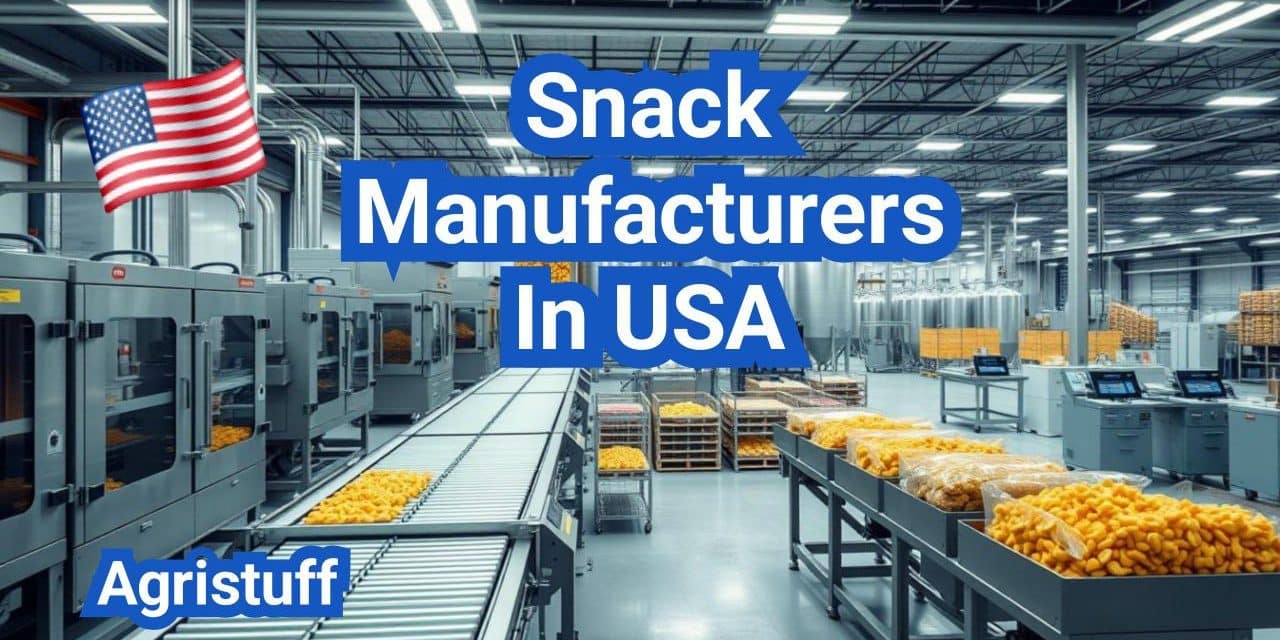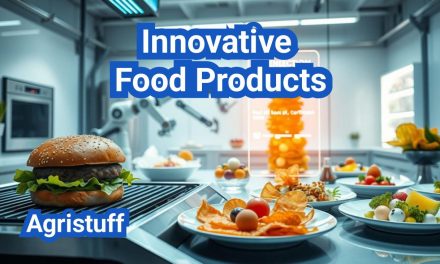The U.S. snack manufacturing industry is characterized by a diverse range of products and manufacturing processes. With a growing demand for convenient and healthy snack options, the industry is witnessing a shift towards healthier alternatives and advanced production technologies.
As consumers become increasingly health-conscious, snack manufacturers in the U.S. are adapting their production methods to meet this demand. This includes a focus on frying vs. baking, innovative seasoning techniques, and ensuring optimal shelf life.
Key Takeaways
- The U.S. snack manufacturing industry is shifting towards healthier options.
- Frying vs. baking is a key consideration for snack manufacturers.
- Innovative seasoning techniques are being used to enhance flavor.
- Shelf life is a critical factor in snack production.
- Advanced production technologies are being adopted to meet growing demand.
The U.S. Snack Manufacturing Landscape
The snack food market in the United States is a dynamic and evolving sector, driven by changing consumer preferences and technological advancements in food production.
Current Market Size and Growth Trends
The U.S. snack food market has been experiencing steady growth, with sales projected to continue rising in the coming years. According to recent industry reports, the market size is expected to expand due to increasing demand for convenient and portable snack options.
Key factors driving this growth include:
- Increasing consumer demand for healthier snack options
- Expansion of distribution channels, including online platforms
- Innovations in snack flavors and product varieties
Consumer Preferences Driving Production Decisions
Consumer preferences play a crucial role in shaping the snack manufacturing landscape in the USA. There is a growing trend towards healthier snacking, with consumers seeking out products that are low in sodium, free from artificial ingredients, and made with sustainable practices.
Manufacturers are responding by:
- Developing products with cleaner labels and fewer ingredients
- Incorporating alternative grains and protein sources
- Enhancing product nutritional profiles through reformulation
By understanding these consumer preferences and adapting production decisions accordingly, snack manufacturers in the USA can remain competitive and capitalize on emerging trends in the market.
Leading Snack Manufacturers in the USA

Leading snack manufacturers in the USA have established themselves through a combination of quality products, efficient production processes, and effective distribution networks. These companies have played a crucial role in shaping the snack food industry, catering to diverse consumer preferences across the country.
Industry Giants and Their Market Share
The U.S. snack food market is dominated by a few industry giants, with Frito-Lay and Snyder’s-Lance being prominent players. Frito-Lay, a subsidiary of PepsiCo, is known for its wide range of snack products, including popular brands like Lay’s potato chips and Doritos tortilla chips. Snyder’s-Lance, on the other hand, has a strong presence in the pretzel and snack nut markets.
| Company | Market Share (%) | Key Brands |
|---|---|---|
| Frito-Lay | 30 | Lay’s, Doritos, Cheetos |
| Snyder’s-Lance | 15 | Snyder’s of Hanover, Lance Sandwich Crackers |
| Kellogg’s | 10 | Pringles, Kellogg’s Snack Bars |
Market Share Distribution: The table above illustrates the market share distribution among leading snack manufacturers in the USA. Frito-Lay holds the largest market share, followed by Snyder’s-Lance and Kellogg’s.
Regional Powerhouses in U.S. Snack Production
Apart from industry giants, regional powerhouses play a significant role in the U.S. snack food industry. Companies like Utz Quality Foods and Rutledge Baking have a strong presence in specific regions, offering a range of snack products that cater to local tastes.
Regional manufacturers often focus on producing high-quality, artisanal snacks that appeal to local consumers. Their ability to adapt to regional preferences and trends has enabled them to maintain a loyal customer base.
Small and Specialized Snack Companies
While big brands often grab the headlines, small snack manufacturers are carving out their own niches in the market. These companies are proving that with the right strategy and product offerings, it’s possible to thrive in a competitive industry.
Niche Market Opportunities | Snack Manufacturers
Small snack companies are finding success by targeting niche markets that larger corporations often overlook. These niches can include special dietary needs, such as gluten-free, vegan, or keto-friendly snacks. By catering to these specific consumer demands, small manufacturers can establish a loyal customer base.
“The beauty of being a small snack company lies in our ability to be agile and responsive to changing consumer preferences,” says a spokesperson for Golden Pacific Foods, a company known for its innovative approach to snack production.
Success Stories: Golden Pacific Foods and TH Foods
Golden Pacific Foods and TH Foods are exemplary models of small snack companies that have achieved significant success. Golden Pacific Foods has built a reputation for its all-natural snack products, while TH Foods has made a name for itself with its diverse range of ethnic-inspired snacks.
These companies have managed to carve out substantial market shares by focusing on quality, unique flavors, and consumer health trends. As noted by industry experts, “Small snack manufacturers like Golden Pacific Foods and TH Foods are leading the way in innovation, often pushing the boundaries of what consumers expect from snack products.”
Boutique Manufacturers’ Competitive Advantages
Boutique snack manufacturers enjoy several competitive advantages. Their smaller size allows for greater flexibility in product development and marketing. They can quickly adapt to new trends and consumer preferences, often introducing new products faster than larger competitors.
- Personalized customer service
- Ability to cater to niche markets
- Flexibility in product development and production runs
- Stronger connections with local suppliers and communities
By leveraging these advantages, small and specialized snack companies can not only survive but thrive in a competitive market dominated by larger players.
Understanding Snack Production Methods

The art of snack production involves a delicate balance of raw material selection, equipment, and quality control. Snack manufacturers must carefully consider these factors to produce high-quality products that meet consumer expectations.
Raw Material Selection and Preparation | Snack Manufacturers
The quality of snack products begins with the selection of raw materials. Manufacturers must choose ingredients that are not only flavorful but also safe and sustainable. The preparation of these raw materials, whether it involves cleaning, cutting, or mixing, plays a crucial role in the final product’s texture and taste.
For instance, potato chip manufacturers select potatoes based on their variety, moisture content, and sugar levels to achieve the perfect crispiness. Similarly, nut producers carefully roast their products to enhance flavor while maintaining nutritional value.
Equipment and Technology Requirements
The equipment used in snack production significantly impacts the efficiency and quality of the manufacturing process. Advanced technologies, such as automated sorting systems and precision cooking equipment, enable manufacturers to produce consistent, high-quality products.
For example, continuous frying systems allow for the production of large quantities of fried snacks while maintaining precise control over oil temperature and product cooking time. Similarly, advanced seasoning applicators ensure uniform flavor distribution across products.
| Equipment Type | Function | Benefits |
|---|---|---|
| Automated Sorting Systems | Sorts raw materials based on size and quality | Improves product consistency and reduces waste |
| Precision Cooking Equipment | Controls cooking temperature and time | Enhances product texture and flavor |
| Advanced Seasoning Applicators | Applies seasonings uniformly | Ensures consistent flavor across products |
Quality Control Checkpoints | Snack Manufacturers
Quality control is paramount in snack production to ensure the safety and quality of the final product. Manufacturers implement various checkpoints throughout the production process, from raw material inspection to finished product testing.
These checkpoints may include monitoring of cooking temperatures, product texture analysis, and flavor profiling. By identifying and addressing quality issues early, manufacturers can prevent costly recalls and maintain consumer trust.
Effective quality control also involves regular maintenance of equipment and training of production staff to ensure that all processes are carried out to the highest standards.
Frying vs. Baking: Production Techniques Compared
The choice between frying and baking is crucial in snack production, influencing not only the taste and texture but also the nutritional value of the final product. Both methods have their place in the snack food industry, catering to different consumer preferences and product requirements.
Deep Frying Process and Equipment
Deep frying is a widely used technique in snack production, known for producing crispy and flavorful products. This process involves completely submerging food products in hot oil, typically between 350°F to 375°F. The equipment used for deep frying includes fryers with sophisticated temperature control systems and oil filtration units to maintain oil quality and ensure consistent product quality.
- Advantages: Produces crispy texture and rich flavor.
- Disadvantages: High oil content, potential for acrylamide formation, and higher production costs due to oil consumption.
Baking Technologies and Systems
Baking is an alternative to frying that has gained popularity due to consumer demand for healthier snack options. Baking technologies range from traditional convection ovens to advanced infrared and microwave baking systems. These technologies allow for precise control over temperature and baking time, enabling manufacturers to produce a variety of textures and flavors.
- Baking offers a lower-fat alternative to frying.
- Advanced baking technologies provide flexibility in product development.
Nutritional and Sensory Differences
The nutritional and sensory differences between fried and baked snacks are significant. Fried snacks generally have a higher fat content and may contain acrylamide, a potential carcinogen formed during high-temperature frying. In contrast, baked snacks are typically lower in fat and do not contain acrylamide. Sensory differences include texture and flavor, with fried snacks often being crisper and having a richer flavor profile.
Nutritional Comparison:
| Nutritional Aspect | Fried Snacks | Baked Snacks |
|---|---|---|
| Fat Content | Higher | Lower |
| Acrylamide Presence | Potential | None |
| Calorie Count | Generally Higher | Generally Lower |
Oil Management in Fried Snack Production

Effective oil management is crucial in fried snack production, impacting both product quality and production costs. As fried snacks continue to be a popular choice among consumers, manufacturers must prioritize oil management to maintain product consistency and quality.
Potato Chip Frying Oil Selection
The selection of frying oil is a critical decision in the production of potato chips and other fried snacks. Different oils have varying smoke points, flavor profiles, and nutritional content, which can significantly impact the final product. For instance, peanut oil is often chosen for its high smoke point and distinct flavor, while sunflower oil is valued for its light taste and high oleic acid content.
“The choice of frying oil can make or break the flavor profile of your potato chips. It’s not just about the cost; it’s about the quality and performance of the oil during frying.”
John Doe, Snack Manufacturing Expert
Oil Filtration and Maintenance Systems
Proper oil filtration and maintenance are essential for extending the life of frying oil and ensuring consistent product quality. Regular filtration removes contaminants and debris that can degrade oil quality and affect the taste and texture of fried snacks. Modern oil filtration systems can significantly reduce waste and lower production costs.
Extending Oil Life and Cost Management
Extending the life of frying oil not only reduces waste but also lowers production costs. Strategies for extending oil life include monitoring oil quality regularly, maintaining optimal frying temperatures, and using oil replenishment strategies. By implementing these practices, snack manufacturers can achieve significant cost savings while maintaining product quality.
- Regular oil testing to monitor degradation
- Optimal frying temperature control
- Oil replenishment to maintain quality
By focusing on effective oil management practices, fried snack manufacturers can improve product quality, reduce costs, and maintain a competitive edge in the market.
Acrylamide Reduction Strategies in Snack Manufacturing

Snack manufacturers are implementing various strategies to minimize acrylamide formation during processing. Acrylamide is a potential carcinogen that forms naturally in certain foods, especially starchy ones, when cooked at high temperatures.
Formation Mechanisms During Processing
Acrylamide forms through the Maillard reaction, a chemical reaction between amino acids and reducing sugars when heated. Factors influencing acrylamide formation include temperature, cooking time, and the presence of precursors like asparagine and glucose.
Key factors contributing to acrylamide formation:
- Cooking temperature above 120°C (248°F)
- Presence of asparagine and reducing sugars
- Moisture content during cooking
- pH level of the food
Mitigation Techniques and Technologies
To reduce acrylamide levels, manufacturers are adopting various mitigation techniques:
Pre-treatment methods: Using asparaginase to break down asparagine, soaking potatoes to reduce sugar content, and blanching to remove excess sugars.
Processing adjustments: Lowering frying temperatures, optimizing cooking times, and using moisture control during processing.
Regulatory Considerations for U.S. Manufacturers
While there’s no federal regulation specifically limiting acrylamide in snack foods, manufacturers must comply with FDA guidance and state regulations. The Food Safety Modernization Act (FSMA) also plays a role in managing potential contaminants.
Manufacturers are advised to implement Good Manufacturing Practices (GMPs) and Hazard Analysis and Critical Control Points (HACCP) plans to minimize acrylamide formation.
On-Machine Seasoning (OMS) Technologies

On-Machine Seasoning (OMS) technologies have revolutionized the snack manufacturing industry by enhancing efficiency and product consistency. These systems allow for the precise application of seasonings directly onto the product during production, streamlining the manufacturing process.
The implementation of OMS technologies represents a significant advancement in snack production. By integrating seasoning application into the production line, manufacturers can achieve uniform flavor distribution, reduce waste, and improve overall product quality.
Equipment and System Configurations | Snack Manufacturers
OMS systems are designed to be versatile and adaptable to various snack manufacturing processes. The equipment configurations can vary based on the type of snack being produced, the desired seasoning application rate, and the production line’s layout.
A typical OMS system includes a seasoning dispenser, a control unit, and application nozzles or drums. The control unit is crucial as it manages the amount of seasoning applied, ensuring consistency across products.
| System Component | Function |
|---|---|
| Seasoning Dispenser | Holds and dispenses the seasoning |
| Control Unit | Manages seasoning application rate |
| Application Nozzles/Drums | Applies seasoning to the product |
Seasoning Application Techniques | Snack Manufacturers
The technique used for seasoning application can significantly impact the final product’s flavor and texture. OMS technologies offer various application methods, including tumbling, spraying, and dusting, to suit different snack types.
For instance, tumbling is effective for coating products evenly, while spraying is better suited for applying seasonings to specific areas of the snack. The choice of technique depends on the product’s characteristics and the desired outcome.
Quality Control and Consistency Management
Maintaining consistency in seasoning application is crucial for product quality. OMS systems are equipped with features to monitor and adjust seasoning levels in real-time, ensuring that every product meets the desired specifications.
“The precision offered by OMS technologies has been a game-changer for our snack production. We can now ensure that every batch is consistently flavored to our high standards.” – John Doe, Snack Manufacturing Expert
Quality control measures include regular calibration of the OMS system, monitoring of seasoning usage, and product sampling. By implementing these measures, manufacturers can ensure that their products maintain the highest quality and consistency.
Water Activity Management in Snack Products

Effective water activity management is vital for snack manufacturers to maintain product texture and freshness. Water activity, a measure of the energy status of water in a product, directly influences the snack’s quality, safety, and shelf life.
Measuring and Monitoring Methods | Snack Manufacturers
Accurate measurement and monitoring of water activity are crucial in snack production. Manufacturers use various methods, including dew point hygrometry and psychrometry, to determine water activity levels. These techniques help ensure that snack products remain within the optimal water activity range, typically between 0.2 and 0.6, to prevent moisture-related issues.
Modern water activity meters provide quick and reliable readings, enabling manufacturers to make informed decisions about packaging, storage, and distribution. Regular monitoring helps detect any deviations from the desired water activity levels, allowing for prompt corrective actions.
Impact on Product Texture and Shelf Life
Water activity significantly affects the texture and shelf life of snack products. High water activity can lead to sogginess, staleness, or the growth of microorganisms, while very low water activity can result in dry, brittle products. Maintaining the optimal water activity level is essential for preserving the desired texture and ensuring the product remains safe for consumption throughout its shelf life.
For instance, in potato chips, a water activity level that’s too high can cause the chips to become stale or develop off-flavors. Conversely, products like dried fruits require careful management to prevent them from becoming too dry or developing texture issues.
Controlling Water Activity During Manufacturing
Controlling water activity during the manufacturing process is critical for achieving the desired product characteristics. This involves careful management of ingredients, processing conditions, and packaging. Manufacturers can implement various strategies, such as adjusting cooking times and temperatures, using moisture barriers in packaging, and controlling the humidity in production and storage areas.
By understanding and managing water activity, snack manufacturers can optimize their production processes, enhance product quality, and extend shelf life. This proactive approach to water activity management contributes to reduced waste, improved customer satisfaction, and a stronger brand reputation.
U.S. Snack Manufacturers’ Packaging Solutions

Packaging plays a crucial role in the snack food industry, with U.S. manufacturers employing various strategies to preserve product quality. The right packaging solutions can significantly impact the shelf life and freshness of snack products.
Oxygen Transmission Rate Considerations
Oxygen transmission rate (OTR) is a critical factor in packaging, as it directly affects the product’s exposure to oxygen. High OTR can lead to oxidation, resulting in off-flavors and rancidity. To mitigate this, manufacturers use packaging materials with low OTR, such as metallized films or foil laminates, to minimize oxygen ingress.
For instance, potato chip manufacturers often use packaging with low OTR to prevent the chips from becoming stale. The choice of packaging material depends on the type of snack product and its sensitivity to oxygen.
| Packaging Material | Oxygen Transmission Rate (OTR) | Suitability for Snack Products |
|---|---|---|
| Metallized Film | Low | High |
| Foil Laminate | Very Low | Very High |
| Polyethylene | Moderate | Moderate |
Moisture Vapor Transmission Rate Management
Moisture vapor transmission rate (MVTR) is another crucial factor in packaging, as it affects the product’s moisture content. High MVTR can lead to moisture ingress, causing snack products to become stale or develop off-flavors. Manufacturers use packaging materials with low MVTR to maintain the product’s texture and freshness.
For example, manufacturers of dried fruit snacks use packaging with low MVTR to prevent moisture from entering the package and causing the product to become soggy.
Nitrogen Flushing and Modified Atmosphere Packaging
Nitrogen flushing and modified atmosphere packaging (MAP) are techniques used to remove oxygen from packaging and replace it with a gas mixture that inhibits spoilage. Nitrogen flushing involves displacing oxygen with nitrogen, while MAP involves using a combination of gases, such as nitrogen, carbon dioxide, and oxygen, to create a modified atmosphere.
These techniques help to extend the shelf life of snack products by preventing oxidation and spoilage. For instance, manufacturers of roasted nuts often use nitrogen flushing to prevent the nuts from becoming rancid.
FSMA Compliance for Snack Manufacturers

FSMA compliance is now a critical aspect of snack manufacturing, requiring companies to adopt a proactive approach to food safety. The Food Safety Modernization Act has transformed the way snack manufacturers operate, emphasizing the need for robust preventive controls, meticulous documentation, and thorough inspection preparation.
Preventive Controls Requirements
Preventive controls are a cornerstone of FSMA compliance. Snack manufacturers must identify and implement controls to mitigate hazards that could impact the safety of their products. This includes:
- Implementing sanitation controls to prevent contamination
- Establishing controls for raw material sourcing and supplier verification
- Developing processes for allergen management and cross-contact prevention
These controls must be part of a comprehensive Food Safety Plan, which is tailored to the specific operations and risks associated with the manufacturing process.
Documentation and Record-Keeping Practices
Effective documentation and record-keeping are crucial for demonstrating FSMA compliance. Snack manufacturers must maintain detailed records of their food safety protocols, including:
- Preventive controls and their implementation schedules
- Monitoring and verification activities
- Corrective actions taken in response to deviations or non-conformities
These records serve as evidence of compliance during FDA inspections and audits, highlighting the importance of accuracy and thoroughness in documentation practices.
Inspection Preparation Strategies
Preparing for FDA inspections is a critical aspect of FSMA compliance. Snack manufacturers should:
- Conduct regular internal audits to ensure compliance with FSMA regulations
- Train personnel on FSMA requirements and their roles in maintaining compliance
- Maintain a state of readiness for inspections by ensuring all records are up-to-date and easily accessible
By adopting these strategies, snack manufacturers can demonstrate their commitment to food safety and compliance with FSMA regulations.
Allergen Cross-Contact Control in Manufacturing

Effective allergen management is crucial in the snack manufacturing industry to prevent cross-contact and ensure consumer safety. Allergen cross-contact occurs when a food allergen comes into contact with a product that does not contain that allergen as an ingredient, potentially leading to cross-contamination.
Facility Design and Production Scheduling
Designing facilities and production schedules to minimize cross-contact is a critical step in allergen management. This involves segregating production lines for products containing major allergens from those that do not. Separate equipment and utensils should be used for allergen-containing products to prevent cross-contamination.
Production scheduling plays a significant role in minimizing allergen cross-contact. Manufacturers can adopt a schedule that dedicates specific production lines or days to products containing major allergens, followed by thorough cleaning before switching to non-allergen products.
Cleaning Validation Protocols
Implementing effective cleaning validation protocols is essential for removing allergens from equipment and production areas. This involves validating cleaning procedures to ensure they are capable of removing allergenic residues to acceptable levels.
Cleaning validation should be performed regularly, and the results documented. This process helps in identifying any areas where allergen cross-contact might occur and allows for corrective actions to be taken.
Allergen Management Documentation
Maintaining comprehensive allergen management documentation is vital for demonstrating compliance with regulatory requirements and for internal control measures. This documentation should include details on allergen identification, risk assessment, control measures, and verification procedures.
Documentation should also cover training programs for employees on allergen management and the procedures for handling products containing allergens. Regular audits of allergen management practices should be conducted to ensure the effectiveness of the control measures.
By focusing on facility design, production scheduling, cleaning validation, and thorough documentation, snack manufacturers can significantly reduce the risk of allergen cross-contact. This not only ensures compliance with regulations but also protects consumers with food allergies.
Private Label Snack Manufacturing Opportunities
Private label snack manufacturing has become a lucrative opportunity for retailers and manufacturers alike. This growing trend is driven by consumer demand for affordable, high-quality snack products.
Contract Manufacturing Business Models
Contract manufacturing is a key component of private label snack production. This business model allows retailers to partner with experienced manufacturers to produce high-quality snack products. Benefits include reduced production costs, increased efficiency, and improved product quality.
Contract manufacturers offer a range of services, including product development, production, and packaging. By leveraging their expertise and resources, retailers can bring their private label snack products to market quickly and effectively.
Finding the Right Manufacturing Partner
Selecting the right manufacturing partner is crucial for successful private label snack production. Retailers should look for manufacturers with experience in producing similar products, as well as a strong track record of quality and reliability.
Key considerations include production capacity, quality control processes, and certifications such as FSMA compliance. By carefully evaluating potential partners, retailers can ensure that their private label snack products meet the highest standards.
Case Studies: Successful Private Label Programs
Several retailers have successfully implemented private label snack manufacturing programs. For example, a major grocery store chain partnered with a contract manufacturer to produce a line of organic snack products. The result was a significant increase in sales and market share.
Another retailer worked with a manufacturer to develop a customized seasoning blend for their private label potato chips. The unique flavor profile helped differentiate their product from competitors and drove customer loyalty.
These case studies demonstrate the potential of private label snack manufacturing to drive business growth and profitability.
Healthy Snack Production Innovations
With the growing trend of health-conscious eating, snack manufacturers are innovating to create healthier products. This shift is driven by consumer demand for nutritious, better-for-you snack options.
Alternative Ingredients and Processing Methods
One key area of innovation is the use of alternative ingredients such as ancient grains, legumes, and plant-based proteins. These ingredients not only enhance the nutritional profile of snacks but also cater to the growing demand for vegan and gluten-free options.
Manufacturers are also adopting alternative processing methods like extrusion and baking to reduce the fat content and increase the fiber content of their products. These methods allow for the creation of snacks that are not only healthier but also more sustainable.
Clean Label Formulation Strategies
Clean label formulation is another critical aspect of healthy snack production. Consumers are increasingly seeking products with simpler, more natural ingredient lists. To meet this demand, manufacturers are reducing the use of artificial preservatives, colors, and flavors.
Instead, they are opting for natural preservatives like tocopherols and plant extracts to maintain product freshness. This approach not only aligns with consumer preferences but also contributes to a cleaner, more transparent product label.
Equipment Modifications for Healthier Products
To produce healthier snacks, manufacturers are also making equipment modifications. This includes upgrading frying equipment to reduce oil absorption, implementing precise seasoning systems to minimize sodium content, and using baking ovens that allow for better control over cooking temperatures and times.
These modifications enable manufacturers to create a wide range of healthier snack options without compromising on taste or texture. By investing in the right equipment and technology, snack manufacturers can stay ahead of the curve in the rapidly evolving healthy snack market.
Snack Mix Components and Production Challenges
Snack mix manufacturers face several challenges, from selecting the right ingredients to ensuring consistent quality in the final product. The complexity of snack mix production lies in combining various components, each with its own characteristics, to create a uniform and appealing product.
Ingredient Selection and Compatibility
The selection of ingredients for snack mix is crucial, as it directly impacts the flavor, texture, and overall quality of the final product. Manufacturers must consider the compatibility of different ingredients, such as nuts, seeds, and dried fruits, to ensure that they work well together. Ingredient compatibility is key to creating a snack mix that is both delicious and visually appealing.
For instance, the moisture content of ingredients can affect the overall texture of the snack mix. Ingredients with high moisture content, like dried fruits, can cause other components to become stale or rancid. Therefore, manufacturers must carefully balance the ingredients to maintain the desired texture and freshness.
Blending and Packaging Considerations
The process of blending snack mix ingredients requires careful attention to ensure uniformity and consistency. Manufacturers use various blending techniques and equipment to combine the ingredients effectively. The blending process must be designed to prevent segregation of ingredients, which can lead to inconsistent flavor and texture in the final product.
Packaging is another critical aspect of snack mix production. The packaging material and design must protect the product from moisture, light, and oxygen to maintain freshness and quality. Modified atmosphere packaging is often used to extend the shelf life of snack mix products by removing oxygen and preventing the growth of microorganisms.
Quality Control for Multi-Component Products
Ensuring the quality of snack mix products is challenging due to their multi-component nature. Manufacturers must implement robust quality control measures to monitor the production process, from ingredient sourcing to packaging. This includes regular testing for texture, flavor, and moisture content to ensure that the final product meets the desired standards.
Effective quality control also involves managing the supply chain and working closely with suppliers to ensure that ingredients meet the required specifications. By maintaining high-quality ingredients and controlling the production process, manufacturers can produce snack mix products that are consistent and appealing to consumers.
Future Trends in U.S. Snack Manufacturing
The U.S. snack manufacturing industry is poised for continued growth, driven by evolving consumer preferences and advancements in production technologies. As consumers increasingly demand healthier and more sustainable snack options, manufacturers are adapting by incorporating alternative ingredients and cleaner label formulations into their products.
New technologies are playing a crucial role in shaping the future of snack production. Innovations in frying and baking technologies, as well as improvements in seasoning application and packaging solutions, are enabling manufacturers to produce high-quality snacks that meet consumer expectations.
The snack industry outlook remains positive, with the U.S. snack food industry expected to continue growing in the coming years. As manufacturers navigate the complexities of changing consumer demands and regulatory requirements, they will need to stay agile and responsive to emerging trends and technologies.
FAQ
What is the difference between fried and baked snack products?
Fried snack products are cooked in oil, resulting in a crispy texture and distinct flavor, while baked snack products are cooked in an oven, resulting in a lower-fat content and different texture.
How do snack manufacturers manage oil in fried snack production?
Snack manufacturers manage oil by selecting the right frying oil, implementing oil filtration and maintenance systems, and using strategies to extend oil life and manage costs.
What is acrylamide, and how can it be reduced in snack manufacturing?
Acrylamide is a potential carcinogen that forms during high-temperature processing. Snack manufacturers can reduce acrylamide by using mitigation techniques and technologies, such as adjusting cooking times and temperatures, and using ingredients that help reduce acrylamide formation.
What is on-machine seasoning (OMS), and how does it improve snack product quality?
On-machine seasoning (OMS) is a technology that applies seasoning directly to snack products during production. OMS improves snack product quality by ensuring consistent seasoning distribution and reducing waste.
How do snack manufacturers control water activity in snack products?
Snack manufacturers control water activity by measuring and monitoring water activity levels, using ingredients that help control water activity, and implementing control measures during manufacturing, such as adjusting humidity and temperature levels.
What are the key considerations for snack packaging?
Key considerations for snack packaging include oxygen transmission rate (OTR), moisture vapor transmission rate (WVTR), and nitrogen flushing and modified atmosphere packaging, which help maintain snack product quality and shelf life.
What is FSMA compliance, and why is it important for snack manufacturers?
FSMA compliance refers to adherence to the Food Safety Modernization Act, which requires snack manufacturers to implement preventive controls, maintain documentation and record-keeping practices, and prepare for inspections to ensure snack product safety and quality.
How can snack manufacturers prevent allergen cross-contact?
Snack manufacturers can prevent allergen cross-contact by designing facilities and production schedules to minimize cross-contact, implementing cleaning validation protocols, and maintaining allergen management documentation.
What are the benefits of private label snack manufacturing?
Private label snack manufacturing allows companies to offer branded snack products without investing in production infrastructure, and can provide access to specialized manufacturing capabilities and expertise.
How are snack manufacturers innovating to produce healthier snack options?
Snack manufacturers are innovating by using alternative ingredients and processing methods, implementing clean label formulation strategies, and modifying equipment to produce healthier snack products that meet consumer demands.
What are the challenges of producing snack mix products?
Producing snack mix products can be challenging due to the need to select and blend multiple ingredients, manage packaging and quality control, and ensure consistency across different components.
What are the future trends in U.S. snack manufacturing?
Future trends in U.S. snack manufacturing include the ongoing growth of the industry, the demand for healthier and more sustainable snack options, and the adoption of new technologies to improve production efficiency and product quality.
Conclusion of: Snack Manufacturers In USA
Snack manufacturers in the U.S.—why this guide matters
U.S. snack manufacturers live at the intersection of taste, safety, and shelf stability. Day to day, teams balance thermal choices (frying vs. baking), select seasoning systems that hit target flavor with minimal waste, and specify barrier packaging that keeps oxygen and moisture at bay—all while complying with FDA requirements on allergens, labeling, and preventive controls. Getting these pillars right is what makes a potato chip stay crisp, a cracker resist staling, and a puff deliver a clean, even seasoning hit across a six-month shelf life. FDA: FSMA preventive controls overview
Frying vs. baking: how process choice shapes texture, flavor, and risk
From a product-development lens, snack manufacturers choose frying for its rapid heat transfer and characteristic Maillard-driven flavor, and baking for a lighter bite and lower oil pickup. Both methods run at high temperature, which is why risk management includes monitoring color targets and time–temperature to control process contaminants like acrylamide in potato and grain matrices. The “best” path is usually driven by brand positioning, fat targets, and desired texture, not dogma. FDA: Acrylamide guidance for industry
Acrylamide mitigation playbook for snack manufacturers
Because acrylamide forms from free asparagine and reducing sugars during high-heat cooking, snack manufacturers reduce formation by controlling raw potato chemistry, blanching, slice thickness, surface pH, and thermal load. Baked crackers and extrudates benefit from similar guardrails: recipe adjustments, color specification, and enzyme strategies where appropriate. These are well-documented, practical levers that protect both consumers and brands. FDA: Acrylamide guidance (PDF)
Oil quality 101: the heartbeat of fried snack lines
For fried products, snack manufacturers keep oil healthy via filtration, turnover, and controlled make-up, then verify degradation with peroxide value, p-anisidine value, and TOTOX. Those metrics quantify primary and secondary oxidation and are standard in specification sheets and shelf-life studies. Using recognized methods and a lab cadence aligned to throughput prevents flavor drift and rancidity complaints. AOCS: Official methods (PV, AV, TOTOX)
Baking lines: cleaner labels, different constraints
When they pivot to baked formats, snack manufacturers often tout lower fat, but they also manage browning, moisture gradients, and acrylamide risk. Uniform airflow, belt loading, and dough or sheet moisture become the levers that decide whether a cracker shatters cleanly or goes tough. As with frying, mitigation relies on validated specs and process windows the team can hold on a busy line. FDA: Acrylamide overview
Seasoning systems at scale: OMS for consistency and speed
Modern snack manufacturers use on-machine seasoning (OMS) positioned at the scale/bagmaker to dose oil and powder precisely, reducing giveaway and dust while enabling rapid flavor changeovers. Integrating metering with drum dynamics improves coverage, adhesion, and sanitation—all crucial when you’re switching flavors and allergens multiple times per shift. Heat and Control: On-Machine Seasoning
Dry, slurry, or two-stage? Getting adhesion right
Because substrates vary (chips vs. puffs vs. crackers), snack manufacturers choose between dry powder, oil/slurry, or two-stage (light oil followed by powder) systems. The goal is even coverage with minimal airborne fines and strong particle adhesion so flavor stays on the snack—not in the bag. Equipment vendors detail how oil spray patterns, drum flights, and feed rates drive results. tna: intelli-flav® OMS 5.1
Process-area vs. on-machine seasoning for snack manufacturers
Some lines, especially extruded or baked bases, get “in-kitchen” or process-area seasoning before packaging, while others finish flavor at OMS. Snack manufacturers weigh product changeover frequency, allergen complexity, and sanitation time to pick the right architecture. The more agile your flavor program, the more OMS flexibility tends to pay back. Heat and Control: Seasoning application overview
Why seasoning science matters beyond the recipe
Even with a great flavor, snack manufacturers must tune powder properties, particle size, oil viscosity, and dwell time to reduce dusting and improve adhesion. Literature on powder coating in foods shows drum design and conveyor approaches alter exposure and coverage, underscoring that consistency is an engineering problem as much as a culinary one. Powder coating in snacks—coverage & efficiency
Sodium targets and flavor impact
Consumer guidance keeps edging sodium downward, so snack manufacturers increasingly use acids, umami builders, and particle-size engineering to deliver impact at lower doses. Keeping formulations aligned with national dietary advice helps brands meet retailer expectations while maintaining flavor leadership. Dietary Guidelines for Americans 2020–2025 (PDF)
Sesame joins the “Big 9”: labeling and changeovers
Since the FASTER Act took effect, snack manufacturers must treat sesame like the other major allergens—on labels and in preventive controls. This matters in seasoning plants, where spice blends or tahini-based inclusions can introduce sesame. Clear labeling, validated cleaning, and production scheduling are frontline defenses. FDA: Sesame is the 9th major allergen
Preventive controls: allergen programs that actually work
Robust FSMA programs help snack manufacturers prevent cross-contact and mislabeling. Practical elements include label control checks at receipt and application, verified sanitation for shared equipment, supplier verification of spice blends, and documented rework rules. Training and records close the loop. FDA Draft Guidance—Food Allergen Program (PDF)
Recalls show why discipline matters
Undeclared allergens remain a leading recall cause. Recent notices involving chips and other snacks illustrate how a single control failure can ripple through supply chains. Snack manufacturers that pressure-test label control and cleaning validation reduce the odds of disruptive market actions. FDA: Lay’s potato chips allergen recall
Water activity (aw): the crispness dial
Crispness and microbial stability are predicted by water activity, not percent moisture. Snack manufacturers manage aw targets to keep chips crunchy, crackers snappy, and bars chew-stable through distribution. Aw specification—paired with packaging barrier and desiccant strategy—drives consistent texture and safety. AQUALAB: Water activity in snack foods
Lipid oxidation and staling: packaging as a “silent ingredient”
Oxygen, light, and time conspire to dull flavors and create rancid notes. Snack manufacturers fight back with oxygen-reducing packaging operations (e.g., gas flush), high-barrier films, antioxidant systems where permitted, and light protection. Getting the headspace right and the barrier strong can add weeks of shelf life. IFT: Packaging strategies to stall lipid oxidation
Barrier science for snack manufacturers: OTR and WVTR
Barrier selection is about controlling oxygen (OTR) and moisture (WVTR). Snack manufacturers specify films and laminations using standardized tests so that oxygen ingress and water vapor gain stay below critical thresholds for flavor and crunch. Knowing the test method helps teams compare apples to apples when sourcing materials. ASTM D3985: Oxygen Transmission Rate
Measuring moisture barrier the right way
For moisture, snack manufacturers lean on ASTM F1249 to quantify WVTR in films and laminates. This number is central to modeling shelf life, especially for high-crisp products that quickly pick up humidity. Buyers, R&D, and packaging suppliers should align on test method and conditions. ASTM F1249: Water Vapor Transmission Rate
Nitrogen flushing (MAP): reducing oxygen and protecting texture
To slow oxidation and protect fragile shapes, snack manufacturers commonly use gas flushing (modified atmosphere packaging) to lower headspace oxygen and create that familiar protective “pillow.” The approach complements barrier films, keeping oxygen low and mechanical damage down through distribution. Packaging & Research: Stalling O₂ with packaging (PDF)
Quality control programs that keep snacks consistent
From incoming raw specs and oil monitoring to finished-goods verification (PV, AV, TOTOX, aw), snack manufacturers standardize lab methods and sampling frequency. This data supports release decisions, trending, and shelf-life modeling, and it gives sales teams confidence when retailers ask for documentation. AOCS: Official analytical methods
Nutrition transparency and label accuracy
When launching baked lines or reformulating salt or oil, snack manufacturers validate Nutrition Facts using laboratory analysis and recognized databases, then re-verify periodically as processes change. Accurate labels reduce legal exposure and align with retailer requirements. USDA: FoodData Central
Putting it together: an end-to-end line that earns its shelf
The most resilient U.S. operations run snack manufacturers through a single integrated lens: validated frying or baking windows; OMS that delivers even seasoning with hygienic changeovers; aw and oxidation in spec; high-barrier packs with gas flush where needed; and FSMA programs that make labels and cleaning bulletproof. That’s how crunchy stays crunchy from week 1 to week 24. FDA: Process contaminant basics
Final thought
At their best, U.S. snack manufacturers treat process, flavor, and packaging as one system: engineer the heat, design the seasoning, measure the water activity, and shield the product with the right barrier and headspace. Pair that with rigorous FSMA allergen controls and clear nutrition, and you’ll deliver snacks that delight consumers and withstand the realities of a long, bumpy supply chain. FDA: Allergen program essentials (PDF)
Sources & References
- FDA—Guidance for Industry: Acrylamide in Foods
- FDA—Acrylamide Guidance (PDF)
- FDA—FASTER Act: Sesame as the 9th Major Allergen
- FDA—Lay’s Classic Potato Chips Allergen Recall
- AOCS—Official Methods (PV, AV, TOTOX)
- AQUALAB—Water Activity in Snack Foods
- IFT—Packaging Strategies to Stall Lipid Oxidation
- ASTM D3985—Oxygen Transmission Rate (OTR)
- ASTM F1249—Water Vapor Transmission Rate (WVTR)
- Heat and Control—On-Machine Seasoning Systems
- tna—intelli-flav® OMS 5.1
- Packaging Technology & Research—Reducing O₂ with Packaging (PDF)
- USDA—FoodData Central










